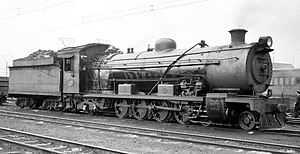Locomotive wheel arrangement
4-8-2 (Mountain) Front of locomotive at left |
 |
|
|
| First known tender engine version |
|---|
| First use | 1906 |
|---|
| Country | Colony of Natal |
|---|
| Locomotive | NGR Altered Class B |
|---|
| Railway | Natal Government Railways |
|---|
| Designer | David Hendrie |
|---|
| Builder | Natal Government Railways |
|---|
| Evolved from | 4-8-0 modified |
|---|
| Evolved to | 4-8-4 |
|---|
| Benefits | Improved stability at speed |
|---|
|
|
Under the Whyte notation for the classification of steam locomotives, 4-8-2 represents the wheel arrangement of four leading wheels, eight powered and coupled driving wheels and two trailing wheels. This type of steam locomotive is commonly known as the Mountain type,[1] though the New York Central Railroad used the name Mohawk for their 4-8-2s.

